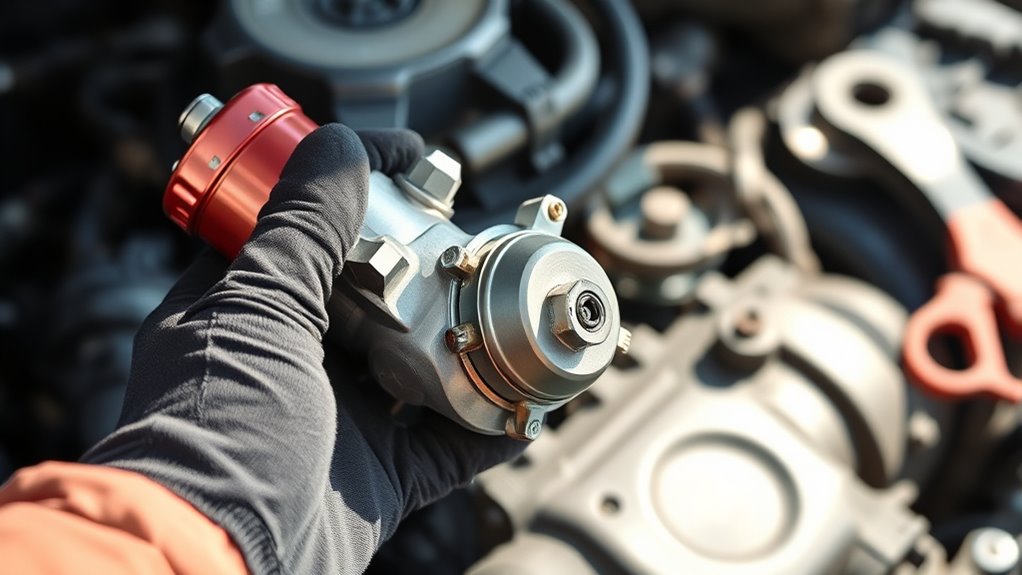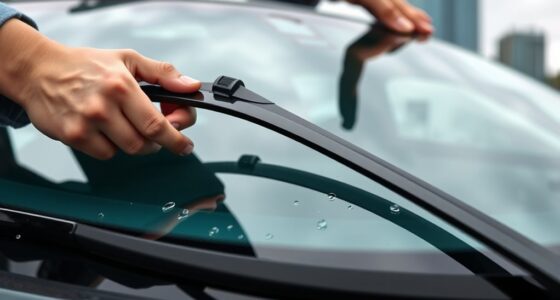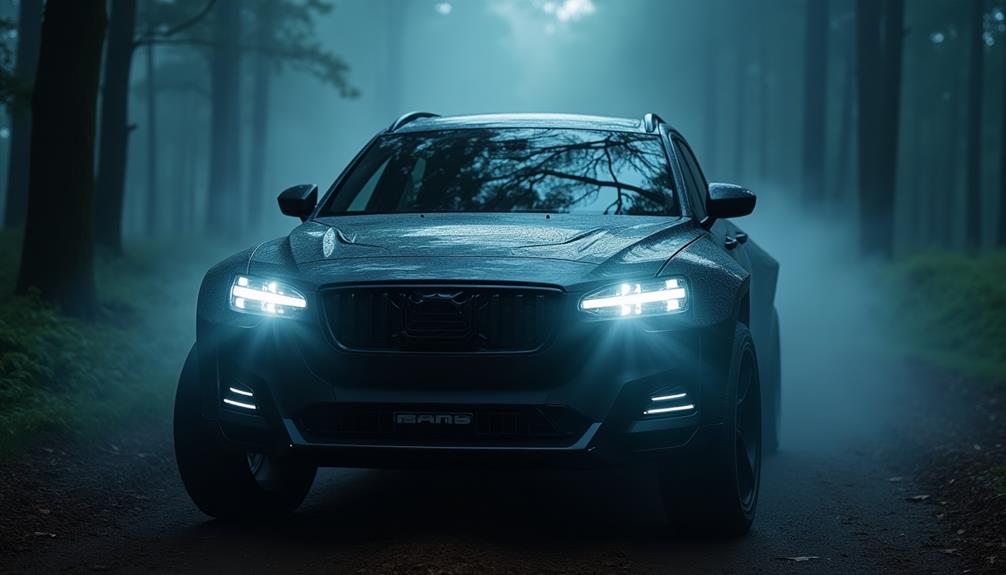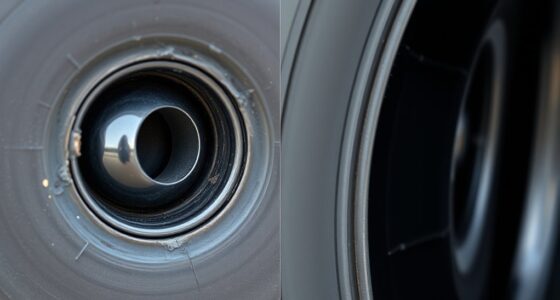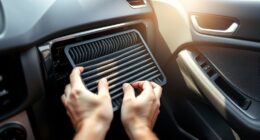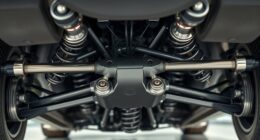Before replacing your starter, it’s essential to diagnose the real problem. Start by testing your battery to make sure it’s fully charged and terminals are clean. Check fuses, relays, and wiring connections for any issues. Conduct a bench test on the starter to confirm if it’s functioning properly. Proper diagnosis helps you avoid unnecessary replacements and saves money. If you want to learn more about guaranteeing a thorough inspection, keep going—it’ll make your repair more reliable.
Key Takeaways
- Always test the battery voltage first to rule out low power as the cause of starting issues.
- Inspect and clean battery terminals and cables to ensure proper electrical connections.
- Check fuses and relays in the starting circuit before considering starter replacement.
- Perform bench testing on the starter to verify its operation independently of the vehicle.
- Confirm all other electrical components are functioning correctly to prevent unnecessary starter replacement.
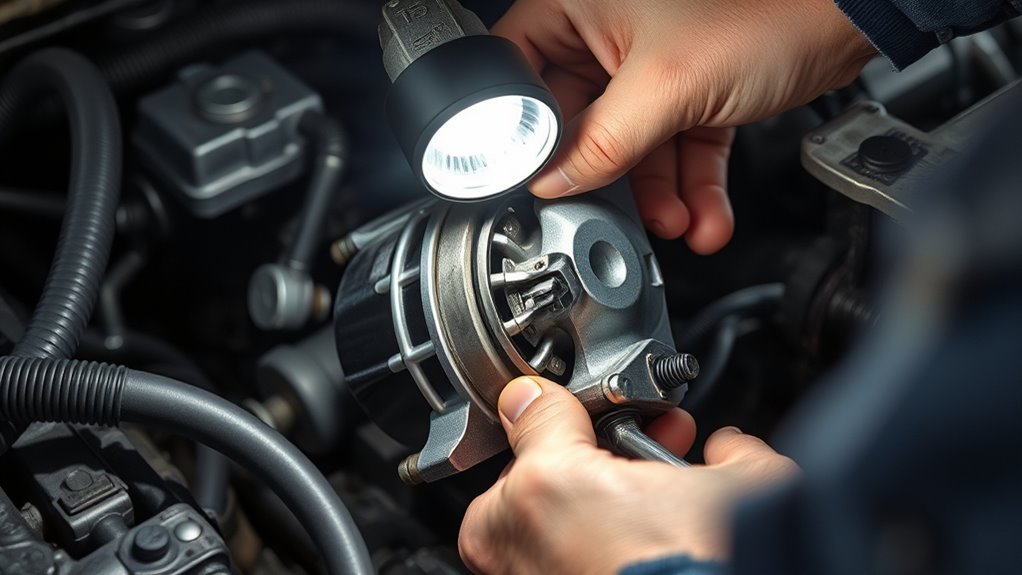
Are you experiencing difficulty starting your vehicle? If so, the first step is to diagnose the problem properly before jumping to conclusions about a faulty starter. Often, what seems like a starter issue could stem from other parts of your vehicle’s electrical system. Start by performing a thorough battery testing, since a weak or dead battery is a common cause of starting problems. Use a multimeter or a dedicated battery tester to check the voltage; a fully charged battery should read around 12.6 volts. If the voltage is low, recharge or replace the battery first, as a poor power supply can mimic starter failure. Remember, even a healthy-looking battery can sometimes have a bad connection or corroded terminals, so inspect the battery terminals and cables for corrosion or looseness and clean or tighten them as needed. Ensuring your battery is in good condition is especially important when dealing with electric bikes that depend heavily on reliable power sources.
Start with thorough battery testing to prevent misdiagnosing starter issues.
Next, you should evaluate your vehicle’s entire electrical system. Sometimes, issues like blown fuses, faulty relays, or damaged wiring can prevent the starter from receiving the proper signals to engage. Check the fuse box for any blown fuses related to the starting circuit and replace them if necessary. Also, listen for clicking sounds when you turn the key; a single click might point to a relay problem, while multiple rapid clicks could suggest insufficient power reaching the starter. If these components seem intact, then focus on testing the starter itself.
When testing the starter, you can try a bench test if you remove it from the vehicle. This involves supplying power directly to the starter to see if it engages and spins freely. If it doesn’t, the starter motor is likely faulty and needs replacement. If it does work during the test, then the issue probably lies elsewhere, such as in the wiring or ignition switch. Keep in mind that sometimes the starter solenoid can fail internally, which may not be obvious from external tests. In that case, replacing the starter becomes necessary. Understanding the horsepower of electric dirt bikes can help you appreciate the power capacity needed for successful starting and operation.
Before replacing the starter, ensure that all other electrical components are working correctly. A detailed diagnosis saves you time and money, preventing unnecessary replacements. Once you’re confident the starter is at fault, you can proceed with a replacement, knowing you’ve eliminated other potential causes. This systematic approach ensures that when you finally replace your starter, you’re addressing the real problem, leading to a more reliable and longer-lasting repair.
Frequently Asked Questions
How Long Does a Starter Replacement Typically Take?
A starter replacement usually takes about 1 to 2 hours. You’ll need to use diagnostic tools to confirm the starter is faulty and follow proper replacement procedures. During this process, you’ll disconnect the battery, remove any components blocking access, and swap out the old starter. If you’re experienced, it’s a straightforward job, but if not, it’s best to let a mechanic handle it to guarantee everything’s done correctly.
Can I Replace the Starter Myself or Need a Mechanic?
Did you know that nearly 80% of car owners attempt DIY repair at some point? You can replace the starter yourself if you’re comfortable with basic tools, but keep in mind that DIY repair can save you money compared to mechanic costs. However, if you’re unsure or uncomfortable, hiring a mechanic guarantees the job’s done right. Weigh your skills and comfort level before tackling the replacement on your own.
What Are Signs That Indicate a Faulty Starter?
You can tell if your starter is faulty by listening for a clicking sound when turning the key, or if the engine doesn’t crank. During starter testing, you might notice slow or no response. An electrical diagnosis can reveal issues like worn brushes or faulty solenoids. If these signs pop up, it’s time to inspect the starter thoroughly to determine if replacement is needed, or seek professional help if unsure.
How Much Does a New Starter Usually Cost?
A new starter typically costs between $100 and $400, depending on your vehicle make and model. During battery maintenance and starter troubleshooting, you might find it helpful to compare prices and consider labor costs. Be sure to verify if your vehicle’s warranty covers replacement. Investing in a quality starter can save you money in the long run, and professional installation guarantees proper functioning.
Are There Any Safety Precautions During Starter Replacement?
A stitch in time saves nine, so prioritize safety. When replacing your starter, always wear safety gear like gloves and eye protection to shield against electrical hazards. Disconnect the battery first to prevent shocks or short circuits. Handle electrical components carefully, and double-check connections before powering up. Remember, safety isn’t just a precaution—it’s a necessity to avoid injury or damage during the replacement process.
Conclusion
Remember, diagnosing your starter before replacing it saves you time and money. For example, if your car struggles to start or makes clicking noises, it might just be a faulty starter rather than a bigger issue. Imagine you’re in a hurry, and after a quick diagnosis, you find the starter’s the culprit. Replacing it promptly gets you back on the road faster. Always diagnose first—you’ll thank yourself later!
